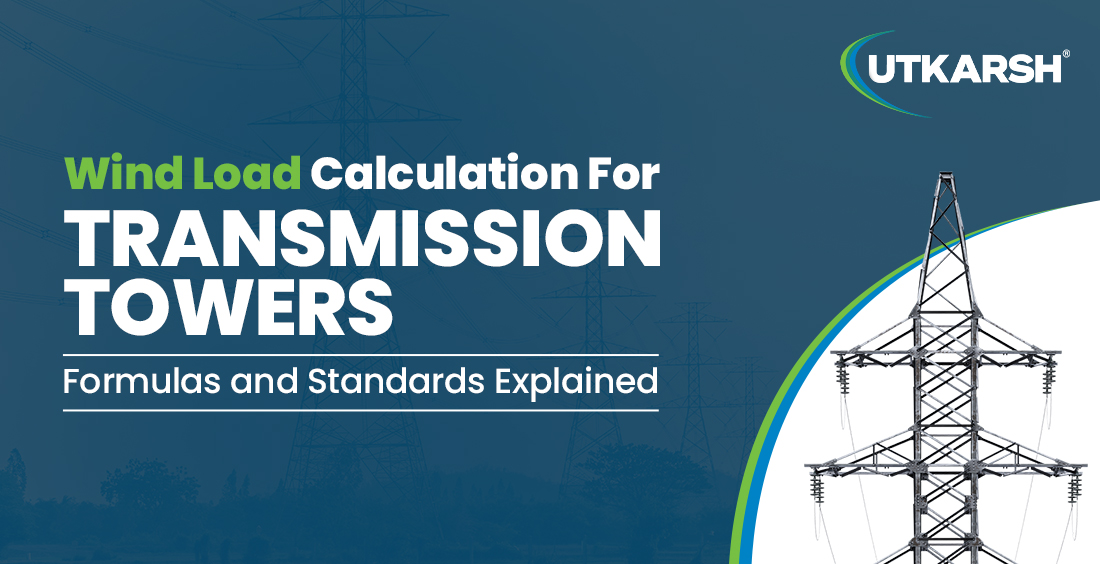Wind Load Calculation for Transmission Towers (Formulas and Standards Explained)

When a transmission tower is standing tall against the wind, it’s not just holding power lines; it’s defying the forces of nature through critical engineering. That fortitude does not arise from anything happening randomly. It’s a result of complex calculations regarding the wind load dynamically checking against IS code, which integrates physics, structural engineering, and civil safety.
How would one define Wind Load Calculation for Transmission Towers?
Wind load assessment for transmission towers refers to estimating the amount of force that will be exerted by the wind on the different parts of a tower. This includes:
The structure of the tower.
The conductors (wires that carry electricity).
The ground wires (for lightning protection).
The basic formula most commonly used is: Force = Area × Pressure × Drag Coefficient
Such an approach tends to simplify matters that are far more complex. Multiple factors tend to alter how these values are calculated. Let's decode that.
Standards that Guide Wind Load Calculation
Wind Load Calculation according to IS Code
This is shorthand for the Indian Standards that engineers follow. The IS 875 code series is widely used, especially:
IS 875 (Part 3) which deals specifically with wind loads.
It defines design wind speed, wind pressure, and methods of calculating loads on buildings and structures, including towers.
Wind Load Calculation as per IS 875
IS 875 gives a detailed method to estimate wind speed at different heights and under varying terrain conditions. Engineers use:
Basic wind speed maps (provided in IS 875)
Adjustments for height, topography, and structure shape
This ensures the wind load calculation IS 875 approach remains consistent across projects in India.
Key Factors Affecting Wind Load Calculation
Height and Terrain Category
The higher the tower, the stronger the wind force it experiences.
Open flat terrains exert more wind pressure than densely built-up areas.
Shape and Size of Structure
Towers with flat members face more wind resistance.
Slender, aerodynamically designed towers have a lower drag coefficient.
This is why wind load calculation for steel structure needs to consider design geometry carefully.
Application of the Generic Wind Load Formula
Let’s say you have a steel tower:
Exposed area = 20 m²
Wind pressure = 1.5 kN/m² (from IS 875 based on wind speed)
Drag Coefficient = 1.2 (depending on shape)
Then the force = 20 × 1.5 × 1.2 = 36 kN
This calculation is repeated for each part of the tower — main body, arms, conductors, and even the insulators. And since each section is at different heights, adjustments are made accordingly as per wind load calculation as per IS 875.
Why Steel Structure Design Matters
Wind load calculation for steel structure is important because towers are exposed 24/7. Poor calculation can lead to:
Structural bending
Conductor sagging
Tower collapse during storms
Following wind load calculation IS 875 ensures the safety and durability of steel lattice towers used in power transmission.
Trusted Transmission Tower Manufacturers: Utkarsh India
A solid structure starts with a trusted partner. Utkarsh India is one of the most reliable transmission tower manufacturers in India. We specialize in high-quality towers for power and telecom sectors. Our portfolio showcases over 600,000 MT of transmission line towers, all built with materials adhering to IS 1852 standards for raw material tolerance. Our expertise means the structures are not just tall—they’re tough, resilient, and precisely engineered.
Know The importance of maintaining telecom towers in remote areas | Utkarsh India Blog
Conclusion
Wind load calculation as per the IS code isn’t just an engineering formality—it’s the spine of safe and reliable transmission infrastructure. Whether it’s a stormy coast or a windy plain, every factor is accounted for using wind load calculation as per IS 875. With careful planning, standard compliance, and the support of expert transmission tower manufacturers like Utkarsh India, our power grids stay strong and steady, no matter how hard the wind blows.
So the next time you see a transmission tower standing tall against the wind, know that behind its strength lies the power of precise wind load calculation IS 875 and smart wind load calculation for steel structure design.